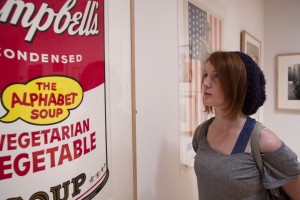From fast-food chains to celebrity tweets and the clothes people wear, iconography is everywhere. Undergraduates of Cornell University’s History of Art Majors’ Society did an adequate job selecting the works featured in “iCON: Consuming the American Image,” an exhibit depicting the heavy influence of icons in everyday life.

The presentation stacks up well with other professionally designed exhibits displayed at the Herbert F. Johnson Museum. It consists of photographs, lithographs and magazine covers, among other forms of media. Though the pieces are evocative and challenge socio-political constructs, they do not mesh well together. For example, the Time Magazine cover celebrating the power of individuality placed a little too close to a nude photo of Marilyn Monroe.
“Consuming the American Image” is too broad a topic to cover in such a small exhibition space. Though the curatorial team makes a decent attempt to work with the allotted space, the mere 33 items on display don’t do the theme justice, especially because icons, such as symbols and advertisements, have been ubiquitous in America since the country’s inception. The selection was inspired by popular artists like Andy Warhol, whose Campbell’s soup prints were extremely influential.
Elliot Erwit’s 1955 “Southern Charm” photo is the most important work on display. The silver gelatin print displays the hues of black and white tones, resulting in a highly contrasted image. The frame shows a weathered black woman walking under a painted “Southern Charm” advertisement.
Erwit poignantly snaps the shot as the woman steps under the “m,” showing the skewed notion of 1950’s southern hospitality.
Surprisingly, only one religious work was on display at the museum: Audrey Flack’s
“Macarena Esperanza.” The piece depicts a figure whose graceful praise and tears streaming down her cheeks will remind viewers of traditional representations of the Virgin Mary. The work speaks to Christians, but it isn’t the most modern or contemporary icon best suited for this collection.
Female sexuality is also dominant in the exhibit. Ruth Bernhard’s “In the Box – Horizontal” is feminine, passive and natural. The female figure is shown in all its glory but isn’t raunchy like Bert Stern’s portrait of Marilyn Monroe, who is nude from the waist up and in a pinup pose.
Ellsworth Kelly’s untitled 1971 screen print depicts a black rectangle above a white one; however, it isn’t representative of American iconography. The meaning of the print is ambiguous and leaves viewers guessing, possibly about the polarizing nature of Civil Rights Movement during the previous decade.
However, James Montgomery Flagg’s 1915 wartime propaganda poster “Be a U.S. Marine,” is crystal clear. The striking imagery of a marine proudly standing in front of old glory conveys American patriotism. It especially resonates with exuberant young men, suggesting that average Joes can become rough, battle-hardened soldiers.
The exhibit interestingly mixes modern art of the early 18th century with contemporary pieces from post-World War II. When viewed as separate works of art, the pieces are highly representative of the era from which they emerged.
While the show’s selection is very limited and some works are reused from recent exhibits, big names like Andy Warhol and his artful muse Marilyn Monroe are well represented. Die-hard patriots fond of Americana art may not find anything new at the exhibit, but for the average viewer, it’s worth a glance.
“iCON: Consuming the American Image” is on display at the Herbert F. Johnson Museum now through June 12. Admission is free.




